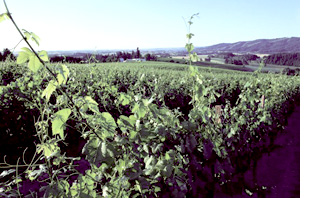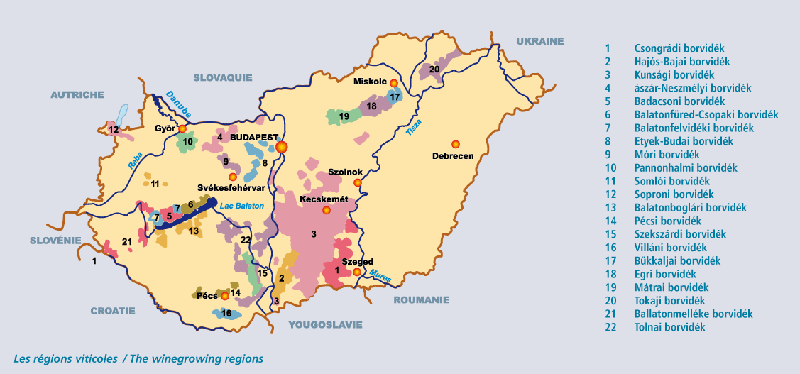World Hungria
Winegrowing in Hungary

Since 1990, the Hungarian winegrowing area has been divided into 22 regions which cover a total area of 150 000 hectares and produce approximately 4 million hectolitres annually.
Hungary can pride itself upon a winegrowing tradition that dates back to Roman times.
Legendary Tokay wines (“Vinum Regum – Rex vinorum”), sold in Europe as of the 17th century, were already remarkable and greatly sought-after at that period. After an interlude corresponding to the duration of the Second World War, Hungarian wines are now once again at the forefront.
Hungary currently holds 14th position as a wine-producing country. It produces essentially white wines, which possess spicy flavours. Rather light red wines are produced in southern Hungary.
The northern part of the country is the birthplace of Tokay wines, grown on 7 000 hectares of volcanic soils. The grapes are harvested in November, in order to allow an optimal development of noble rot, botrytis.
Tokay wines, made mainly with the Furmint and Harslevelu varieties, are not vinified straight away. After light crushing, the grapes are poured into large casks containing dry white wine made with non-botrytised grapes. This mixture is left to macerate for the alcoholic fermentation. A part will be transformed into alcohol and the blend gains in aromatic richness. The wine is aged in barrels for several years. Once bottled, these wines have exceptional ageing potential: as much as two hundred years for the finest.

The winegrowing regions:
EGER: Located near the old town of Eger, this region produces red wines.
ETYEK – BUDA: Near to Budapest, white and sparkling wines are made here.
VILLANY – SYKLOS: A region in southern Hungary. Villany produces red wines similar in style to those of Bordeaux, whereas Skylos specialises more in white wines.
SOMLO: is a small, remote volcanic mountain area found to north of Balaton; white wines which have the reputation of possessing genesic properties are made here.
SOPRON: Located in the furthest western part of Hungary, near to the Austrian border, Sopron is well-known for its light red wines and sweet whites that resemble Austrian wines.
BADACSONY: Situated on the northern bank of Lake Balaton, the basaltic soils of this region give white wines bursting with aromas.
BALATONFURED – CSOPAK: To the north-east of Lake Balaton, the hills of this region enjoy the advantage of having a particularly warm climate. White wines made here have a most distinct character.
DEL – BALATON: This region is found on the southern bank of Lake Balaton; the grapes are grown on sandy soils and produce excellent white and sparkling wines.
TOKAY – HEGYALY: A unique winegrowing region and birthplace of Royal wines. It is found in the north-eastern part of Hungary, along the border with Slovakia. Tokay Aszu is made here.
SZEKSZARD: Located in the southern central part of Hungary, this region is reputed for producing the finest and fruitiest red wines in the country.
The main grape varieties:
For red wines:
Kékfrankos (light or robust wines, depending upon the region),
Kadarka (a very common variety in Hungary),
Kékoporto (wines of a crimson colour),
Kékburgundi (wine: Grand Burgundy),
There are other imported varieties too, such as Merlot or Médoc Noir, Pinot Noir and other Cabernets.
For white wines:
Furmint (used for making legendary Tokay wines),
Harslevelu (second variety used for making Tokay),
Zeusz (aromatic sweet white wines),
Tramini (Gewürtztraminer),
Leànyka (aromatic dry white wines),
Szürkebarat (a variant of Pinot Gris),
Olaszrizling (a variant of Riesling),
Kéknyelu (aromatic wines),
Other imported varieties include Sauvignon, Muscat de Lunel and Chardonnay.

